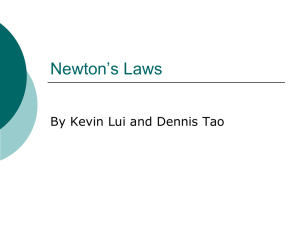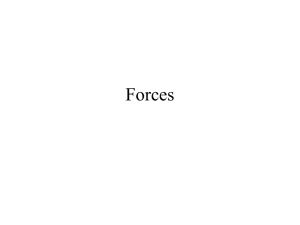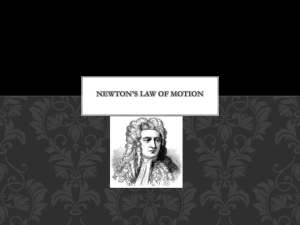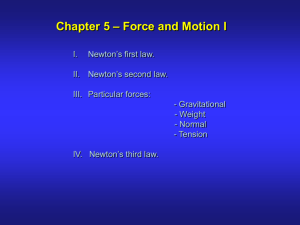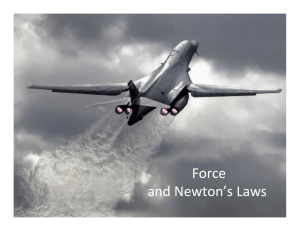5 - Wiley
advertisement
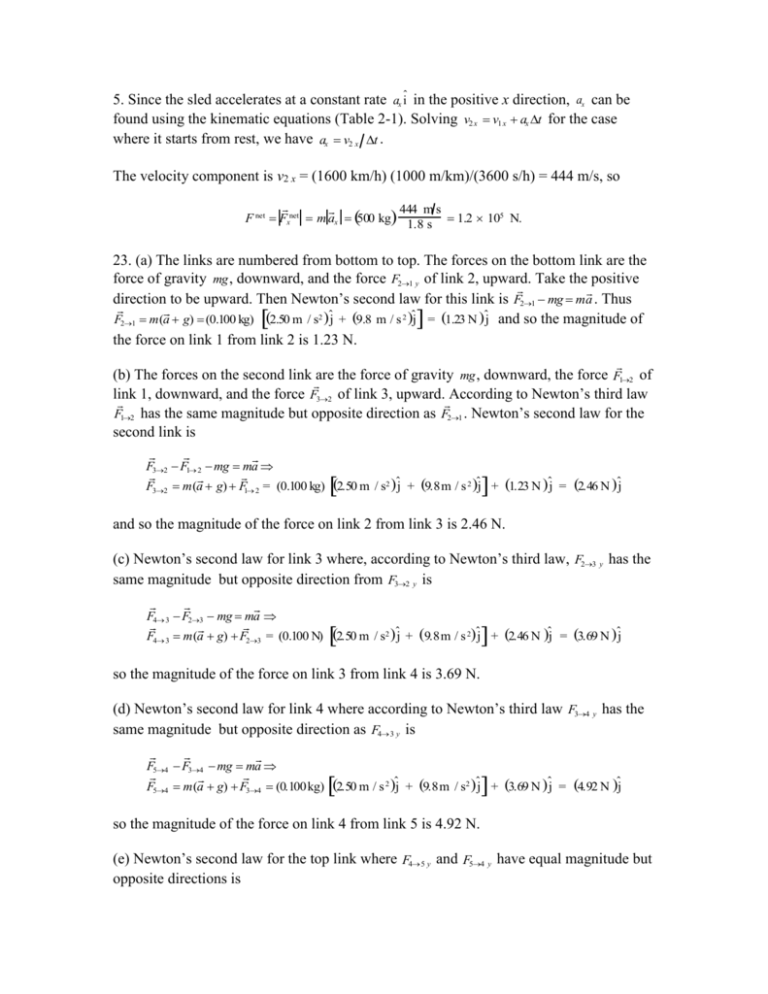
5. Since the sled accelerates at a constant rate ax ˆi in the positive x direction, ax can be found using the kinematic equations (Table 2-1). Solving v2 x v1 x ax t for the case where it starts from rest, we have ax v2 x t . The velocity component is v2 x = (1600 km/h) (1000 m/km)/(3600 s/h) = 444 m/s, so F net Fxnet m ax 500 kg 444 m s 1.2 105 N. 1.8 s 23. (a) The links are numbered from bottom to top. The forces on the bottom link are the force of gravity mg , downward, and the force F21 y of link 2, upward. Take the positive direction to be upward. Then Newton’s second law for this link is F21 mg ma . Thus F21 m(a g) (0.100 kg) 2.50 m / s2 ˆj + 9.8 m / s 2 ˆj = 1.23 N ˆj and so the magnitude of the force on link 1 from link 2 is 1.23 N. (b) The forces on the second link are the force of gravity mg , downward, the force F12 of link 1, downward, and the force F32 of link 3, upward. According to Newton’s third law F12 has the same magnitude but opposite direction as F21 . Newton’s second law for the second link is F32 F1 2 mg ma F32 m(a g) F1 2 = (0.100 kg) 2.50 m / s2 ˆj + 9.8 m / s 2 ˆj + 1.23 N ˆj = 2.46 N ˆj and so the magnitude of the force on link 2 from link 3 is 2.46 N. (c) Newton’s second law for link 3 where, according to Newton’s third law, F23 y has the same magnitude but opposite direction from F32 y is F4 3 F23 mg ma F4 3 m(a g) F23 = (0.100 N) 2.50 m / s2 ˆj + 9.8 m / s 2ˆj + 2.46 N ˆj = 3.69 N ˆj so the magnitude of the force on link 3 from link 4 is 3.69 N. (d) Newton’s second law for link 4 where according to Newton’s third law F34 y has the same magnitude but opposite direction as F43 y is F54 F34 mg ma F54 m(a g) F34 (0.100 kg) 2.50 m / s 2 ˆj + 9.8 m / s2 ˆj + 3.69 N ˆj = 4.92 N ˆj so the magnitude of the force on link 4 from link 5 is 4.92 N. (e) Newton’s second law for the top link where F45 y and F54 y have equal magnitude but opposite directions is F F4 5 mg ma F m(a g) F45 (0.100 kg) 2.50 m / s2 ˆj + 9.8 m / s 2ˆj + 4.92 N ˆj = 6.15 N ˆj so the magnitude of the force on the top link is 6.15 N. (f) Each link has the same mass and the same acceleration, so the same net force acts on each of them: F net ma (0.100 kg)(2.50 m / s2 )ˆj = 0.25 N ˆj . 39. We use the notation gc as the acceleration due to gravity near the surface of Callisto, m as the mass of the landing craft, ay as the acceleration of the landing craft, and F as the rocket thrust. We take down to be the negative y direction. Thus, Newton’s second law in component form takes the form Fy – mgc = may. If the thrust is F1 y (= 3260 N), then the acceleration is zero, so F1 y – mgc = 0 N. If the thrust is F2 y (= 2200 N), then the acceleration is a2 y (= – 0.39 m/s2), so F2 y = mg – mgc = ma2 y. (a) Equation 3-7 gives the weight of the landing craft: mgc = F1 y = 3260 N. (b) The second equation above gives the mass: m F2 y mgc a2 y 2200 N 3260 N 2.7 10 3 kg . 0.39 m/s 2 (c) The weight divided by the mass gives the acceleration due to gravity: gc = (3260 N)/(2.7 103 kg) = 1.2 m/s2 so its magnitude is 1.2 m/s2.
